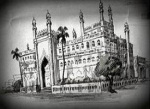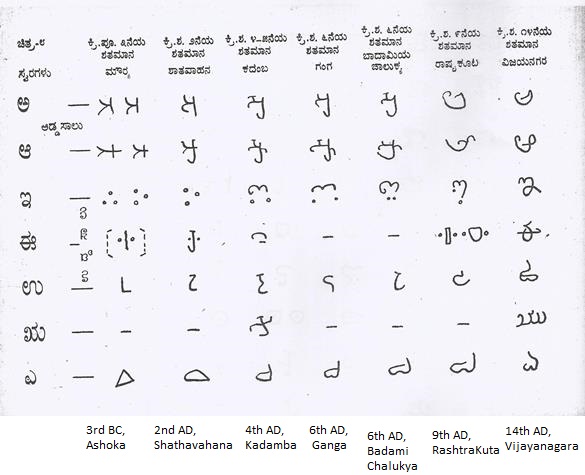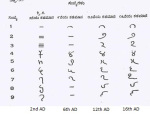Karnataka – Its Antiquity
 |
 |
 |
 |
The earliest reference to Karnataka is in Panini’s work where he calls Karnadhaka as the gotra of a people. Allusion to Karnataka as a territory is found for the first time in Mahabharata, the antiquity of whose composition is carried back to at least 2000 years. In the Kumbhakonam edition of the Mahabharata, in ‘Bhishma Parva’, it is stated that in the southern part of India has the following territories.
Athapare janapadah dakshina Bharatharshabha
Darvidah Kerala Prachya Mushika Vanavasikah
Karnataka Mahishaka Vikalpah Mushakasthatha ….
In the Pune edition of Mahabharata, the word ಕುಂತಲ – ‘Kunthala’ or ಉನ್ನತ್ಯಕ ‘Unnathyaka’ is used as a substitute for Karnataka. ‘Unnathyaka’ means an elevated land, same as the meaning of the word, ‘Karnataka’. The name ‘Kunthala’ was also used for parts of Karnataka.
In the old Sanskrit texts like Markandeya Purana, Bhagavatha, and Brihathsamhitha of Varahamihira, Karnataka is pre-eminently mentioned. Similarly, ancient Tamil works have also referred to the people of this land as Karunadars or Karunatakars. The Birur Plates of Kadamba Vishnuvarman say that Shantivarman was “the master of the entire Karnataka region”. This record of c.450 is the first inscriptional reference to the name. Sanskrit poetess Vijayanka called herself as ಕರ್ನಾಟರಾಜಪ್ರಿಯ – “karnatarajapriya”, and she was a Chalukyan queen. The army of the Chalukyas of Vathapi is called ಕರ್ನಾಟಬಲ – Karnatabala in the inscriptions of the Rashtrakutas. Thus, the land was known as Karnata from quite a long time, not only in Northern India but also in the South. The territory was known by this name even overseas as found in an inscription of a ruler called Srivijaya Airlinga of Java belonging to the 11th century. It states that traders from many countries including Karnata came to trade in Java island.
Among the dynasties which ruled Karnataka region, the Badami Chalukyas, the Rashtrakutas and the Kalyana Chalukyas maintained a vast empire from the Cauveri to the Narmada. They could dominate Indian politics together for nearly five centuries, from the 7th to the 12th. Their victories in the North against the rulers of Kanauj gave them lot of prestige. The belief that Karnataka forces were invincible struck. Thus, Jaina scholars, and warriors from Karnataka during the period gained great regard. The Senas who founded a dynasty in Bengal called themselves as Karnata Kshatriyas. A dynasty founded in Mithila (Bihar) called itself as of Karnata Vamsha. Karnataka came to enjoy great prestige from the days of Pulikeshi II who defeated Harsha of Kanauj.
Antiquity of Kannada Language
The famous Halmidi Record of the Kadambas which is an inscription of the 5th century, is the oldest available written in the Old Kannada script. We have a Badami Record of Mangalesha too dated 578 A.D. in Kannada. Kappe Arabhatta’s Record at Badami (700 A.D.) has the first Kannada poem in ತ್ರಿಪದಿ tripadi metre. Oldest available literary work in Kannada is ಕವಿರಾಜಮಾರ್ಗ Kavirajamarga, a book on poetics belonging to 9th century. This work speaks of some earlier poets in Kannada. Hence, Kannada must have been a fully developed language by the 5th or the 6th century A.D and must have been a spoken language for at least a few centuries earlier.Kannada is among more than 20 languages of the Dravidian group. It is one of the oldest Dravidian languages . The name Isila found in one of the Ashokan inscriptions in Karnataka has been described as a Kannada word by Prof. D.L. Narasimhachar. According to him, it means “throw an arrow”. Thus, Kannada was a spoken language during the 3rd century B.C. itself. The next important document that helps us to prove the antiquity of Kannada is The Geography written by Ptolemy, a scholar from Alexandria, during the first half of the second century A.D. Ptolemy speaks of many places in Karnataka such as Kalgeris (identified as Kalkeri), Modogoulla (Mudugal), Badamios (Badami) and so on. All these are not only places in Karnataka, but are also names of Kannada origin.
Source Material for Historical Study

Inscriptions on boulders, pillars, stones, copper plates, palm leaf manuscripts, and coins
The source material for the study of the history of Karnataka are inscriptions, coins, and a number of kaiphiyats, bakhairs and chronicles and abundant literary sources written in Kannada and Sanskrit. The Karnataka State Archives is a great repository of paper documents. The inscriptions are mostly lithic writings. So far as the history of Karnataka is concerned, more than 30,000 inscriptions are available. They are mostly published in the volumes of Epigraphia Indica and Indian Antiquary, and the regular epigraphical series like Epigraphia Carnatica , South Indian Inscriptions, Karnatak Inscriptions, and Mysore Archaeological Reports.
Inscriptions
The earliest stone records are Ashokan. They are 13 in number, and are found in Chitradurga, Bellary, Raichur districts and three are found at Sannati in Gulbarga. They are in the Prakrit language and the Brahmi script.
There are a number of Shatavahana Records in the same language and script found in Belgaum, Gulbarga and North Kanara districts and also in Maharashtra where they are numerous.
From the 5th century onwards, we have Sanskrit documents such as the Talagunda Record of the Kadambas and the Aihole Record of Pulakeshin II, which is in Kannada script and is one of the earliest records with a Shaka date. Most of the records of the Kadambas, the Gangas and the Chalukyas of Badami are in Sanskrit. A good number of the Ganga Records are copper plates. The earliest lithic documents in Kannada are the Halmidi Record of the Kadambas and the Badami Cave Record of Mangalesha which are of the 5th and the 6th centuries respectively. The Gangas and the Chalukyas have left a good many records, and mention must be made of the Kanchi Record of Vikramaditya II in commemorating his victory over the Pallavas. The Badami Cliff Record, the Mahakuta Pillar Inscription of Mangalesha and the Aihole Record of Pulakeshin II are the most important sources for the study of the Chalukyas.
A majority of the documents of the Rashtrakutas are copper plates and mention must be made of the Samangad Plates of Danthidurga dated 754 A.D., the Talegaon Plates of Krishna I, the Jetwayi Plates of Dhruva and the Sanjan Plates of Amoghavarsha. British Museum Plate of Govinda III is one of the earliest copper plates in Kannada. The Belmannu Plates from Dakshina Kannada is the earliest Kannada copper record from the State.
Of the Chalukyas of Kalyana, the records of Vikrama VI are numerous. The Vadageri and Hyderabad museum inscriptions help us to fix the date of the era started by him in 1076 A.D. The Raibag Record of 1077 A.D., informs us of his victory over Dhara.
Of the Sevunas, Kalachuris and the Hoysalas, inscriptions are numerous. The Sangamaner Record of Bhillama II is the earliest of the Sevuna Records, dated 1000 A.D. It gives us details of the early rulers of the family. Scores of records pertaining to the rule of Singhana, Bhillama V, Jaitugi and Singhana II are available. A majority of the records are in Kannada language.
More numerous are the records of the Hoysalas. Of the Hoysala Records, one at Belur dated 1117 A.D., speaks of the early rulers of the family and the early achievements of Vishnuvardhana. There are many records of the dynasty in Tamilnadu.
There are as many as 7,000 inscriptions of the Vijayanagara period and of these nearly 300 are copper plates. The latter are mostly in Sanskrit with Nandi Nagari script. Most of their stone records are in the regional languages, and of these those in Kannada are almost half in number. The Sringeri Grant of Sangama Brothers dated 1346 A.D., Beluru Record of Harihara II which mentions the appointment of Mudda Dandanayaka as the Prithvisetty and defines his powers of collecting duties over specific goods from 26 recognised fairs in the empire, and Hampi Record of Krishnadevaraya dated 1510 A.D., which commemorates his victory over Adilshah are the most important.
The Odeyars of Mysore and the rulers of Keladi have also left numerous lithic and copper records. Inscriptions continue to be useful source material even for the study of the history of the Muslim rulers like the Bahman Shahis, the Adilshahis and Haider Ali and Tipu. Minor rulers like those of Chitradurga too have left behind numerous stone records. The Maratha rulers in Bangalore, during the 17th century, have also left more than a dozen stone records in Bangalore and Kolar districts. They are in Kannada except the one in the Nandi Fort, of Sambhaji Bhosle, son of Shivaji. This document is in Sanskrit. A Persian Record at Doddaballapur speaks of the capture of the place by Aurangazeb from Sambhaji.
The stone records are of various types. A majority of them are grants made to temples or scholars. Considerable number of them are viragals or herostones, commemorating the exploits of warriors, while fighting an enemy or driving back of a cattle raid. Some of the viragals have beautiful sculptured representations of war scenes. Mention must be made of a Ganga Record from Begur, preserved in the Bangalore Museum. You can read more about inscriptions, their varieties here.
Inscriptions generally contain data helping the historian to reconstruct the chronology. Many times they contain details like the tithi (lunar date), the month, the weekday and other facts. A majority of records in Karnataka contain Shaka Era (wrongly called as Shalivahana Era.) There are a few records which contain the Yudhishthira or Kali Era. The Chalukya Vikrama Era initiated by Vikrama VI of Kalyana was popular for almost a century in Karnataka. The Muslim Records contain the Hijara (A.H.). There are a few lithic records of the 19th and 20th centuries A.D.
COINS
The next important source material are the coins. Punch- marked coins of pre-Christian era have been found in Karnataka in abundance. Most of them are yet to be studied. At Sindhogi near Koppal a large hoard was found. A large number of coins of the Shatavahanas of silver, lead and potien have been unearthed and they have helped the reconstruction of the Shatavahana chronology. There are not many coins of the subsequent centuries though we have a few coins of the Gangas (with their royal emblem of elephant struck on them), the Kadambas, the Chalukyas, the Rashtrakutas and the Hoysalas, some of them with Kannada legends. Coins of the time of Vijayanagara, Varaha, Pratapa and Hana are the most prominent. The Mysore and the Keladi rulers also issued coins with Kannada legends and these coins resemble those of Vijayanagara. The Bahaman Shahis and the Adilshahis struck coins resembling those of the Delhi Sultans. But, their Persian calligraphy is of the southern style. Haider and Tipu also issued coins, with Persian legends, of gold, silver and copper. The latter issued very beautiful coins with greater variety.
Coins of Karnataka (1975) by Dr. A.V. Narasimha Murthy introduces Karnataka’s coins in detail.
Literary Sources
Literary sources are the next important material.
The earliest extant Kannada work ಕವಿರಾಜಮಾರ್ಗ Kavirajamarga speaks of contemporary social and political conditions of Karnataka.
The Kannada poem by Pampa, ವಿಕ್ರಮಾರ್ಜುನ ವಿಜಯಾ – Vikmmurjunavijaya, furnishes certain details regarding the Rashtrakutas.
Ranna’s ಗಧಾಯುದ್ಧ Gadayuddha deals with the history of the Chalukyas of Badami and Kalyana.
ಚಾವುಂಡರಾಯ ಪುರಾಣ Chavundaraya Purana contains information regarding the Gangas.
ಕೆಳದಿನ್ರುಪವಿಜಯಂ Keladinripa Vijayam discusses in detail the history of Keladi family. In Sanskrit, an encyclopedia by Basavaraja, a Keladi ruler, ಶಿವತತ್ವರತ್ನಾಕರ Shivatattva Ratnakara, throws light on the history of Keladi and also on that of Vijayanagara.
ಕಂಠೀರವ ನರಸರಾಜ ವಿಜಯಮ್ Kanthirava Narasaraja Vijayam deals with the exploits of Kanthirava Narasaraja Odeyar of Mysore.
ಚಿಕ್ಕದೇವರಾಜ ಬಿನ್ನಪಂ Chikkadevaraja Binnapam, Chikkadevaraja Vijayam, Chikkadevaraja Vamshavali and ಅಪ್ರಥಿಮವೀರಚರಿತೆ Apratimaviracharite help us to know the achievements of Chikkadevaraya, the great ruler of Mysore.
ಕುಮಾರರಾಮನ ಕಥೆ Kumara Ramanakathe by Nanjunda contains information on the history of pre-Vijayanagara period.
In Sanskrit the achievements of Vikrama VI of Kalyana are narrated in Bilhana’s Vikra- mankadeva Charitam. Manasollasa or Abhilashitartha Chintamani by Somesvara III of Kalyana also contains valuable information on cultural history. This prince also wrote Vikramankabhyudyam narrating the exploits of his father.
Chaturvarga Chitamani of Hemadri deals with the history of the Sevunas (Yadavas). Jalhana’s Suktimuktavali narrates briefly the achievements of Sevuna Bhillama V and his father Mallugi.
Gadyakarnamritam by Vidyachakravartin II describes the war between Hoysala Narasimha II and the Pandayas.
Madhura Vijayam by Gangambika, Saluvabhyudayam by Rajanatha Dindima I, Achyuthabhyudayam by Rajanatha Dindima III and Varadambikaparinayam by Tirumalamba are most notable literary sources.
ಕೃಷ್ಣದೇವರಾಯನ ದಿನಚರಿ Krishnadevarayana Dinachari is a recently discovered Kannada source.
On the Muslim rulers of the Deccan, the account of Ferishta is the most important. His Tarikh-e-Ferishtaor Gulshan-e-Ibrahimi, deals with, among many other things, the history of the Bahamanis. Futu-us- Salatin by Isamy and Burhan-e-Masiroi Tabataba are other notable sources.
Similarly there are accounts on Adilshahis of Bijapur like Tazquirat-ul-mukal of Sirazi, Zaffarnama Nizamshahi of Hussain Shauqi, Alinama of Ali II, Ibrahmi Nama by Abdul Dehlavi and Tarikh-e-Sikandan of Mulla Nusrati. They are all in the Persian language. Basatin-us-Salatin by Zubairi written in 1825 is also a noted history of the Adilshahs in the Persian language.
Nishan-e- Hydari by Kirmani is a noted work on Haider Ali. He has also written on Tippu Sultan.
Foreigners Account
The next group of source material is the accounts left by foreign writers and travellers.
Periplus of the Eritrean Sea, a work by an anonymous author in Latin, and Ptolemy’s Geography (written by this Greek geographer from Alexandria in c 130 A.D.) inform us about the trading connection Karnataka had with other South Indian states and Western countries.
Cosmos Indikapleistus, an Egyptian sailor, in his Greek work Christian Topography speaks of the Konkan coast.
Hiuen-Tsiang, the celebrated Chinese traveller, had visited the court of Pulakeshin II and he reveals interesting details about the conditions of the Chalukyan empire. Tabari, the Arab historian, while writing on the history of the Sassanid empire of Persia, also speaks of the exchange of embassies between Persia and the Chalukyan empire.
A number of Arab travellers who have visited West India during the days of the Rashtrakutas also tell us about the empire of the Balharas, i.e., the Vallabhas or the Rashtrakutas that ruled in Karnataka. Foremost among them is Sulaiman who writes in 851 that the empire of the Rashtrakutas was one of the four great empires of the world. Mention must also be made of the Arab writers like Ibn Haukal, Al-Masudi and Al-Estakhri who speak of the Rashtrakuta empire.
Ibn Batuta, a traveller from Tangier (in modern Morocco) who visited India during the early days of the Vijayanagara empire, speaks of the Karnataka coast, and also of the last days of Hoysala Ballala III. The Vijayanagara empire was fortunate in having a number of European visitors, most important of them being Nicolo Conti, an Italian who came in the days of Deva Raya I, Abdur Razzak from Persia (1442-43), Barbosa (1500-1511), Domingo Paes (1520-22), FernaoNuniz (1537) and Manuel Barradas (1616), all from Portugal. Paes and Nuniz have left detailed accounts about the empire. Caesar Fredericei gives us some details about the great battle of 1565. John Linschoten (1583) was a Dutch who visited the West Coast.
Of the visitors who toured the Deccan Shahi kingdoms, Nikitin, a Russian, who had visited Bidar, and Ralph Fitch, an Englishman, who had come to the Adilshahi kingdom, are notable.
To the court of Keladi came Pietro Della Valle (1623), an Italian, and Peter Mundi, an Englishman. They have left detailed accounts behind them.
We have a series of writers who inform us about the history of Haider and Tipu. Theyinclude Alfred Lyal, Elphinston, Abbe Dubbois and Piexoto to mention only a few. The foreign travellers’ accounts have helped us to fill certain major gaps in the history of India and Karnataka.
Newspapers, biographies, autobiographies and archival materials are useful for modern period. ಸ್ವಾತಂತ್ರ್ಯ ಸಂಗ್ರಾಮದ ಸ್ಮೃತಿಗಳು Swatantrya Sangramada Smritigalu compiled by Suryanath Kamath is a major source on the freedom movement.


